TOP ADVICE FOR DESIGNING YOUR GARDEN
Four different designers in four different climates share what they learned while creating their own home gardensWhether you plan to build a garden from scratch or will be making revisions to your current garden, it’s always helpful to get ideas and guidance from those who have been designing gardens for years. Four designers in New York, California, Washington State, and England share what they learned as they designed their own personal gardens.
STORYBOOK BEAUTY
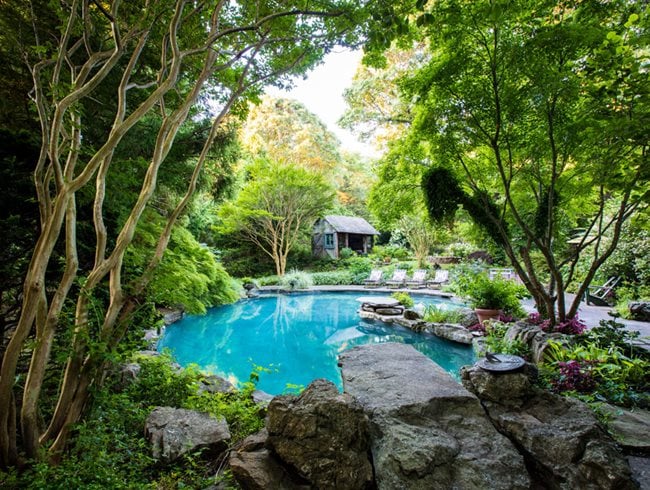
At their home in Long Island, NY, designer Conni Cross and her husband naturalized the edges of an irregularly shaped swimming pool with moss rock and woodland plantings, allowing it to blend seamlessly into the wooded setting. Graceful crape myrtles and Japanese maples frame the pool with an engaging display of color in all seasons. Photo by: Claire Takacs.
New York garden designer Conni Cross shares what she’s learned while designing her garden in Long Island, New York—an ongoing project that she has been working on for more than 30 years.
Do research. We are all prone to impulse buying and taking home plants with a pretty face. I’ve learned to research plant varieties thoroughly and to choose wisely when it comes to foundation trees and shrubs that will last for many years.
Incorporate layers. Planting in layers mimics the canopy found in nature. You can fill gaps around foundation trees and shrubs with shorter-lived perennials.
Encourage exploration. Design an outdoor space so that you can’t see everything at once, to create a feeling of intrigue and mystery.
Combine styles. Combining formal plants, such as boxwood, with naturalistic plants, such as Japanese maple, lends structure and balance.
Plant for all four seasons. This is a hallmark of my designs. Choose plants with flowers, berries, bark, fragrance, and compelling structure.
Plan for growth. Whatever the spacing says on the plant label, double that figure. Happy plants inevitably grow larger than their estimated size.
Maintain the space. Regular maintenance is an often-overlooked component of designing a garden. I like to stay true to the original design as much as possible.
WATERWISE & WORRY-FREE
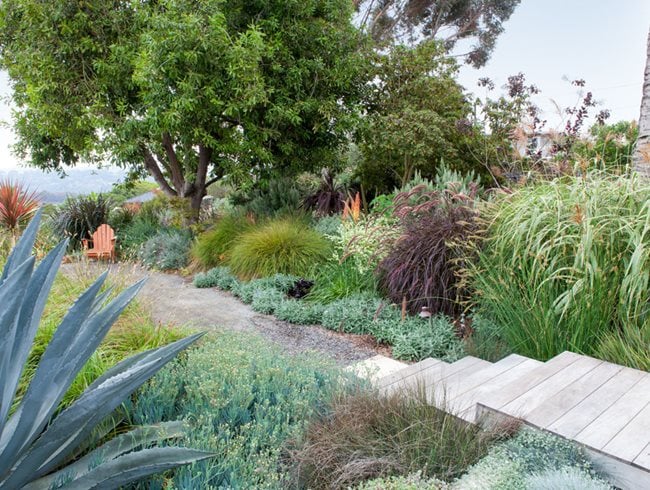
Richly layered plantings of ornamental grasses, perennials, and succulents outline the boardwalk and gravel path that lead from the house down the backyard slope at Debora Carl’s property in Encinitas, CA. Blue chalksticks—Carl’s favorite go-to groundcover—complements repeating peach-apricot highlights of Kniphofia (center) and Cordyline (far left). Photo by: Richard Bloom.
At her property in Encinitas, California, designer Debora Carl created a sleek, modern, color-rich, waterwise garden. Here are a few tips she learned along the way.
Site strategically. Place seating areas and other significant features close to the house where you will be more likely to enjoy them. Elements placed too far away may feel isolated, and therefore may be used less often.
Use color wisely. Combine plants with complementary colors such as blue and orange to create visual tension. Adding another pop of color such as red lends an additional layer of complexity and creates an unexpected surprise. Repeat these same colors to unify the landscape and establish order.
Create visual balance. Use strong, straight lines and axes to define the structure of a garden, and soften the edges with plants.
Tie elements together. Match the color of your exterior paint to a dominant flower or foliage color in a planting bed, then apply the same paint to a piece of garden furniture for repetition and a pleasing composition.
Add a focal point. Use a sculpture, garden art, or an interesting container to give the eye a place to pause and appreciate the surroundings.
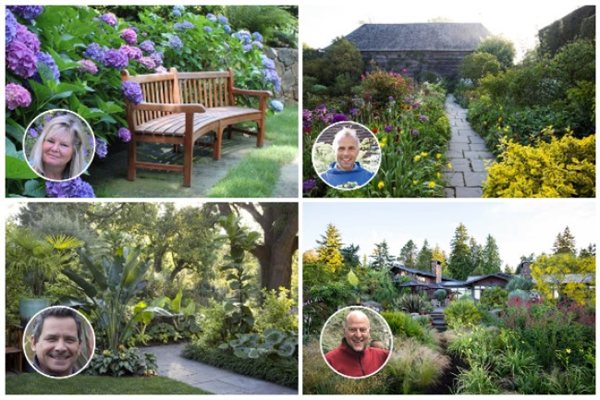
NORTHWEST TRANQUILITY
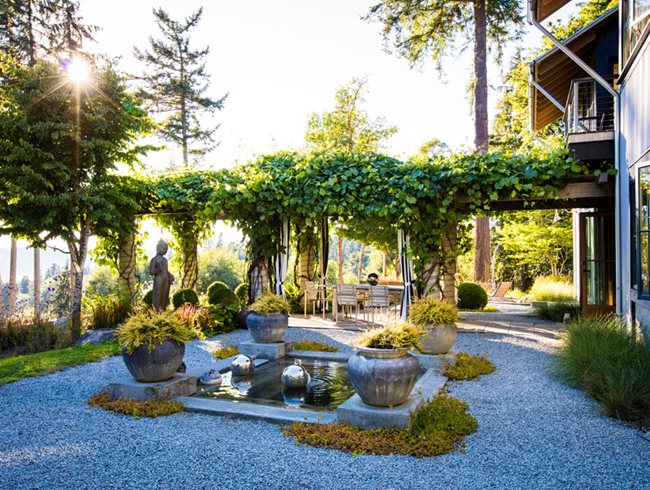
At this home in Vashon Island, WA, a European-inspired fountain was placed outside the kitchen window and next to an arbor-covered dining area where it can be enjoyed year-round. When David Pfeiffer and his partner, David Klein, decided to simplify the garden a few years ago, they removed aquatic plants from the fountain and replaced them with stainless steel gazing balls that constantly move, reflecting the sky as they float on the surface of the water. Photo by: Claire Takacs.
Designer David Pfeiffer and his partner, Daniel Klein, took an undeveloped property on Vashon Island near Seattle and transformed it into a garden with dedicated areas for dining, lounging, quiet contemplation, and entertaining. Pfeiffer shares some of his tips for designing.
Unite garden and home. Design the garden the same way you would design the floor plan for your home. Decide how you want to live and entertain in your garden, and be sure your pathways, terraces, and furniture layouts reflect this.
Remember that less is more. Limit garden decoration and accessorizing. Instead, rely on architectural elements such as arbors, stairs, and walls to unify the house with the garden. Limit the amount of plant varieties, and plant in large textural drifts to help focus the eye. Choose plants that require minimal pruning and watering.
Design based on how you like to entertain. Include dining and conversation areas that accommodate how you live.
Tie it all together. For hardscape and planting choices, hold true to the vernacular of your home’s architecture and the area you live in. It doesn’t have to be strictly native, but use local materials when possible for a regional aesthetic (and to lighten your carbon footprint).
Encourage exploration and discovery. Key features such as a swimming pool or seating should be conveniently placed, but also include destinations like a bench or gazebo farther out that serve as destinations and surprises.
STRUCTURE & STYLE
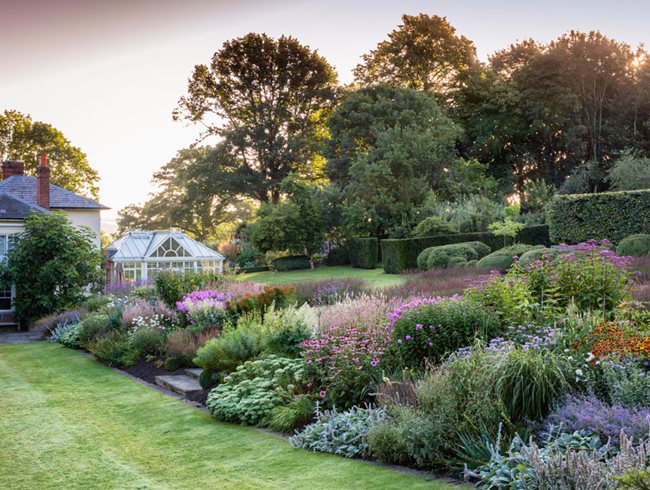
This classic English-style perennial border at the home of Jeremy and Beverly Allen in southeast England is more than 100 yards long. The border was inspired by the grand borders at Great Dixter and Sissinghurst Castle Garden and positioned to take advantage of the borrowed views of majestic shade trees and clipped hedging beyond, adding an extra dimension of layering and height. Late-summer perennials—coneflower, phlox, Joe Pye weed, catmint, asters, and ornamental grasses—create a restful tapestry of texture and form. Photo by: Richard Bloom.
Garden designer Jeremy Allen and his wife, Beverly, transformed a dense thicket into a beautiful countryside landscape with neatly defined garden rooms. Here are some of Allen’s tips for designing.
Use strong shapes. Using uniformly straight or curving lines for elements such as hardscape, hedges, or planting beds lends order to a space.
Install structural elements first. Installing hardscape and planting trees, shrubs, and hedges first will define the structure of your garden. This will provide a good stage set to show off other plants and winter interest when perennials go dormant.
Consider how and where light falls. Light and shadows create ambience and animate a space. A carefully placed tree or interesting topiary can create diffused light or atmospheric shadows.
Choose plants that provide consistent form, texture, and foliage. The secret to achieving a good-looking border is selecting plants that continue to provide an attractive overall shape both before and after flowering.
Use repetition. Repeating the same plants throughout a border and in different areas of your garden creates visual rhythm. It also creates cohesion and makes a garden feel whole, even if areas are disparate from each other.
These tips were excerpted from the article “Dream Gardens” in the Winter 2018 issue of Garden Design magazine.
RELATED:
Landscape Design Rules
2021 Garden Trends
Backyard Landscaping


